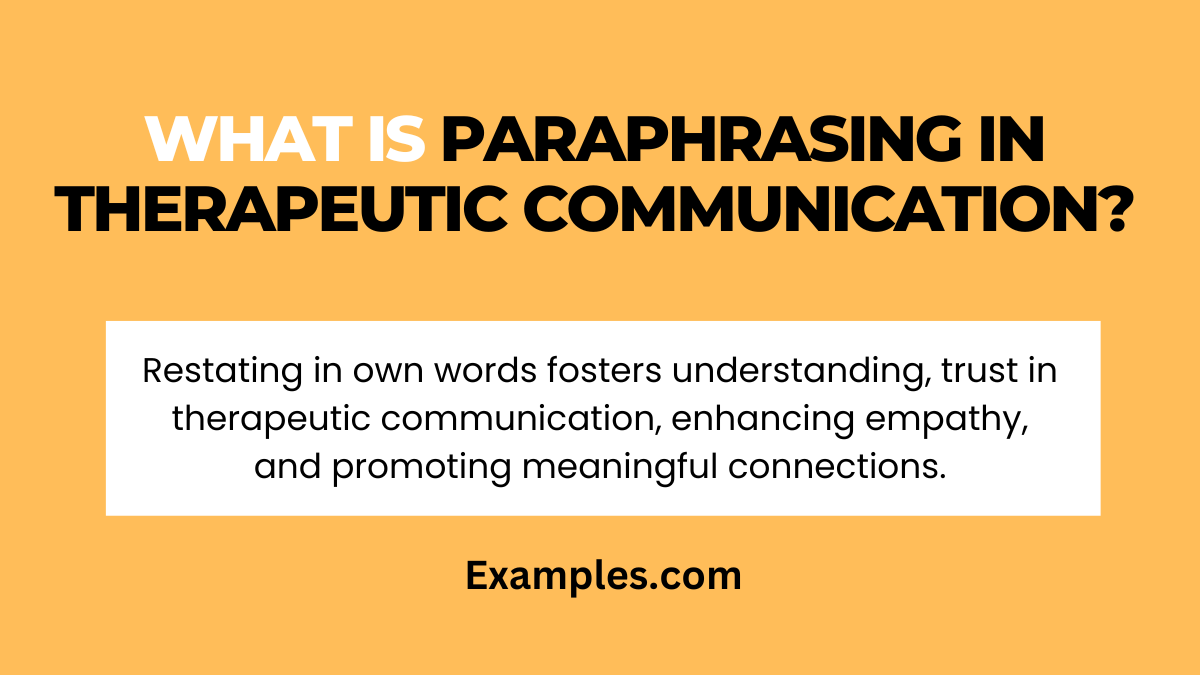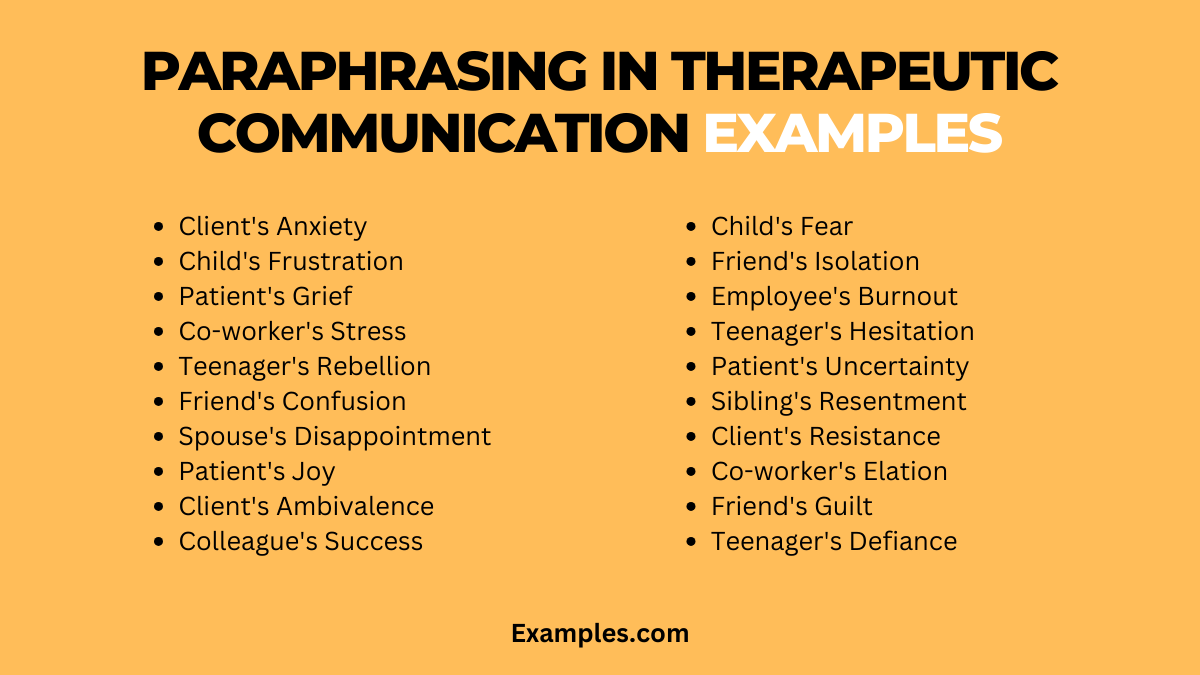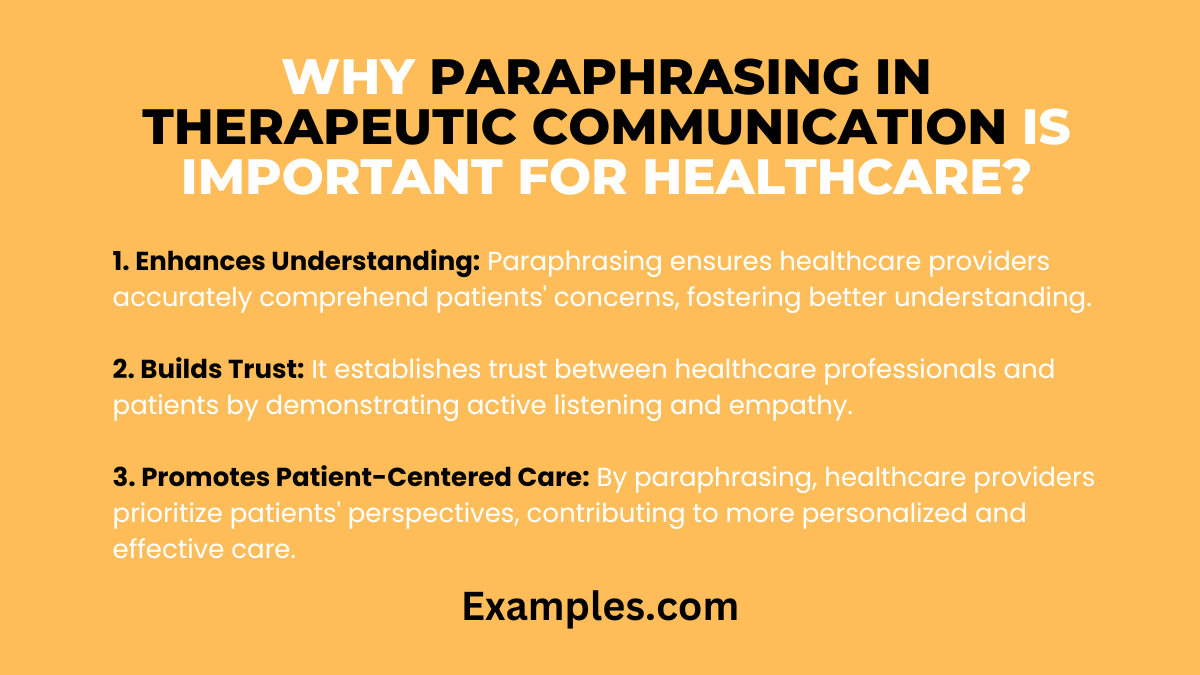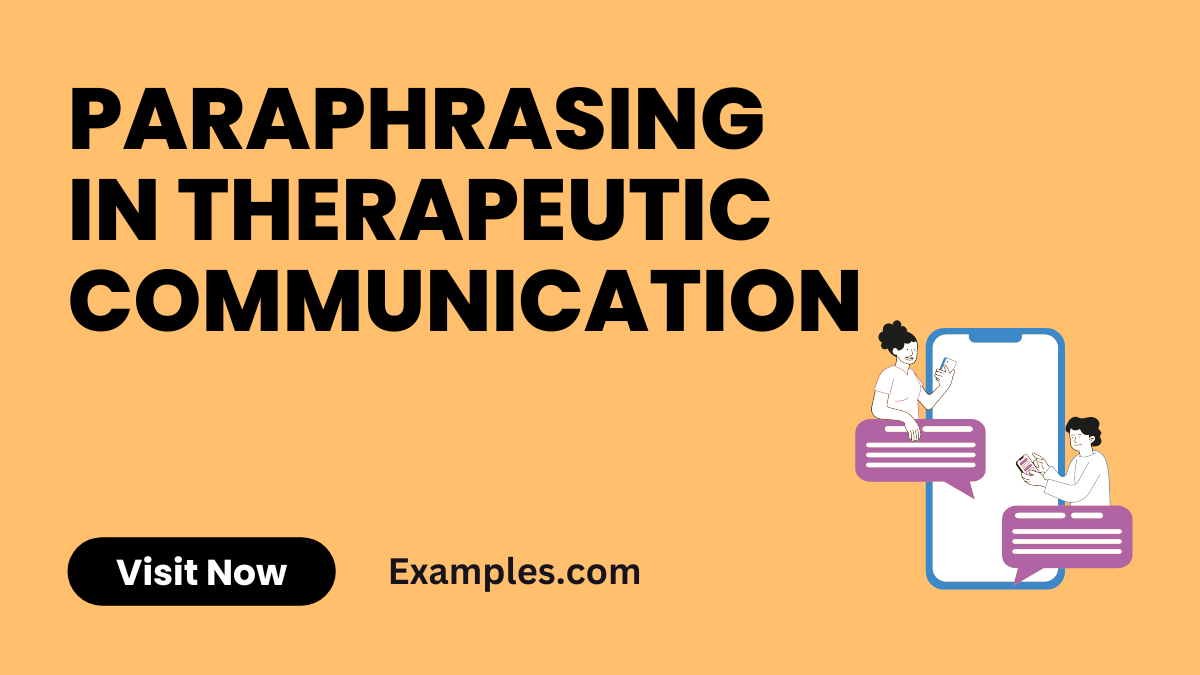19+ Paraphrasing in Therapeutic Communication Examples
Unlock profound connections with Paraphrasing in Therapeutic Communication. This comprehensive guide delves into the art of rephrasing, empowering you with effective communication examples. Elevate your interactions with therapeutic finesse, understanding the pivotal role of paraphrasing in fostering genuine connections. Gain valuable insights and masterful techniques to enhance your therapeutic skills. Dive into a world where words create bridges, not barriers. Communication examples illuminate the transformative power of paraphrasing in forging meaningful connections.
What is Paraphrasing in Therapeutic Communication?

Paraphrasing is a communication technique where a listener rephrases or rearticulates the speaker’s words. In therapeutic communication, this skill is employed to convey understanding, validate emotions, and promote a deeper connection. It involves capturing the essence of the speaker’s message while using one’s words, fostering trust, and facilitating meaningful dialogue. By mastering this technique, practitioners enhance empathy, ensuring clients feel heard and valued in the therapeutic process.
20 Paraphrasing in Therapeutic Communication Examples

Paraphrasing in therapeutic communication involves skillfully rephrasing a speaker’s words to convey empathy and understanding. This technique fosters a deeper connection and validates the speaker’s feelings, contributing to a supportive therapeutic environment.
- Client’s Anxiety: “You seem anxious about the upcoming session. Let’s explore your concerns together.”
- Child’s Frustration: “It looks like you’re frustrated with homework. Tell me more about what’s challenging.”
- Patient’s Grief: “Expressing sadness about the loss. I hear you. Share more about your feelings.”
- Co-worker’s Stress: “Noticing stress at work. Can you elaborate on specific stressors you’re facing?”
- Teenager’s Rebellion: “Rebelling against rules. Help me understand what you find restrictive.”
- Friend’s Confusion: “Detecting confusion. Let’s clarify any points causing uncertainty in our discussion.”
- Spouse’s Disappointment: “Your disappointment is apparent. Share more about what didn’t meet your expectations.”
- Patient’s Joy: “Expressing joy after progress. Celebrate this achievement and share more about it.”
- Client’s Ambivalence: “Mixed feelings detected. Let’s explore your conflicting thoughts and emotions.”
- Colleague’s Success: “Noticing success in your project. Congrats! Share more about your key strategies.”
- Child’s Fear: “Detecting fear during our activity. Let’s address and work through these fears together.”
- Friend’s Isolation: “Your isolation is noticeable. Is there something you’d like to discuss or share?”
- Employee’s Burnout: “Signs of burnout are evident. Let’s strategize ways to manage and alleviate stress.”
- Teenager’s Hesitation: “Hesitation detected in your response. What reservations or concerns do you have?”
- Patient’s Uncertainty: “Noticing uncertainty about treatment. Share your concerns and let’s address them.”
- Sibling’s Resentment: “Your resentment is apparent. Let’s explore the roots and work towards resolution.”
- Client’s Resistance: “Detecting resistance in our conversation. Can we discuss the source of discomfort?”
- Co-worker’s Elation: “Elation detected in your demeanor. Share the positive news; I’m here to listen.”
- Friend’s Guilt: “Detecting guilt in your expression. Let’s talk about what’s weighing on your conscience.”
- Teenager’s Defiance: “Defiance observed. Help me understand the reasons behind your opposition.”
Paraphrasing in Therapeutic Communication Examples for Nursing Students
Paraphrasing in therapeutic communication is vital for nursing students to enhance patient interactions. It involves restating patients’ concerns in a supportive manner, promoting empathy and understanding within the healthcare context.
- Patient’s Pain Disclosure: “You’re expressing discomfort. Can you share more about the type and intensity of the pain?”
- Family’s Concerns: “Your family seems worried. What specific concerns do they have about the treatment plan?”
- Patient’s Anxiety: “I sense anxiety. Help me understand the triggers so we can work towards a calming approach.”
- Concerns about Medication: “You have reservations about medication. What aspects make you hesitant or uncertain?”
- Patient’s Emotional Expression: “Your emotions are evident. Let’s explore what’s behind this emotional response.”
Paraphrasing in Therapeutic Communication Example for Patients
Patients benefit from paraphrasing in therapeutic communication as it ensures their feelings are accurately interpreted, fostering trust and collaboration with healthcare providers.
- Acknowledging Fear: “I see fear in your expression. Can we discuss specific fears or concerns about the procedure?”
- Understanding Discomfort: “You seem uncomfortable. Share more about the discomfort so we can address it effectively.”
- Expressing Uncertainty: “Detecting uncertainty. What information or details would help clarify your understanding?”
- Sharing Symptoms: “You’ve mentioned symptoms. Let’s delve deeper into each symptom for a comprehensive understanding.”
- Concerns about Treatment: “Noticing concerns about the treatment plan. What aspects are causing hesitation or worry?”
Why Paraphrasing in Therapeutic Communication is Important for Healthcare?

Paraphrasing plays a crucial role in therapeutic communication within healthcare settings. Here’s why it’s paramount:
- Enhances Understanding: Paraphrasing ensures healthcare providers accurately comprehend patients’ concerns, fostering better understanding.
- Builds Trust: It establishes trust between healthcare professionals and patients by demonstrating active listening and empathy.
- Promotes Patient-Centered Care: By paraphrasing, healthcare providers prioritize patients’ perspectives, contributing to more personalized and effective care.
- Clarifies Information: Paraphrasing helps in clarifying medical information, ensuring patients grasp treatment plans, diagnoses, and instructions accurately.
- Encourages Open Communication: Patients feel more encouraged to share their thoughts and emotions when healthcare providers paraphrase, promoting open dialogue.
What is the Technique for Paraphrasing in Therapeutic Communication?
Mastering the technique of paraphrasing in therapeutic communication involves specific strategies:
- Active Listening: Engage in active listening to grasp the essence of what the patient is expressing.
- Use Empathetic Language: Choose words that convey empathy, understanding, and validation.
- Rephrase with Sensitivity: Paraphrase the patient’s statements with sensitivity, maintaining the emotional tone.
- Seek Confirmation: After paraphrasing, seek confirmation from the patient to ensure accuracy and alignment with their feelings.
- Avoid Distorted Interpretation: Be cautious not to distort the meaning of the patient’s message while paraphrasing, aiming for an accurate representation.
- Adapt to Patient’s Communication Style: Tailor paraphrasing to align with the patient’s communication style and preferences.
- Encourage Further Expression: Paraphrasing should invite patients to elaborate on their feelings or concerns, facilitating deeper communication.
- Offer Validation: Conclude the paraphrase by validating the patient’s emotions or experiences, reinforcing a supportive therapeutic environment.
Tips for Effective Paraphrasing in Therapeutic Communications
- Active Listening: Pay close attention to patients’ verbal and nonverbal cues to understand their message fully.
- Use Open-Ended Questions: Encourage patients to share more details, allowing for a comprehensive paraphrasing response.
- Reflect Emotions: Paraphrase not only the content but also the emotional tone, showing empathy and understanding.
- Avoid Jargon: Use simple and clear language, avoiding medical jargon to ensure patients comprehend the paraphrased information.
- Check for Accuracy: Confirm with patients if the paraphrased statement accurately reflects their thoughts and feelings.
- Respectful Tone: Maintain a respectful and non-judgmental tone while paraphrasing to create a supportive environment.
- Offer Validation: Acknowledge patients’ experiences and feelings through paraphrasing to make them feel heard and validated.
In conclusion, mastering the skill of paraphrasing is pivotal in therapeutic communication, especially within healthcare. This guide explored its significance, techniques, and real-life examples. By fostering understanding, trust, and patient-centered care, effective paraphrasing becomes a cornerstone for building meaningful connections between healthcare providers and patients, ultimately enhancing the overall healthcare experience.



